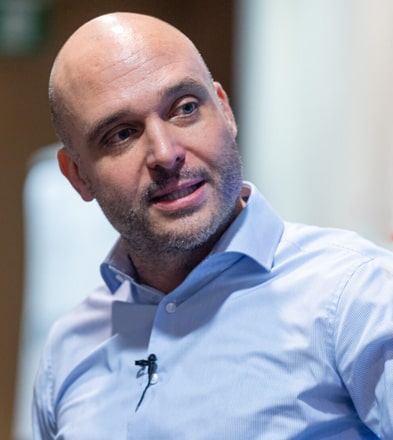
Do you want to automate your trading?
Join EPAT® and learn algorithmic trading on weekends.
learn
- Six months online part-time course
- Experts and practitioners as trainers
automate
- Automate your own trading strategies
- Network with data providers & brokers
trade
- Start your own Algo trading desk
- Join Quant & Algo trading firms

industry recognition
CPD
EPAT is accredited by CPD, UK (Continuing Professional Development, UK)
IBF
This programme has been accredited by The Institute of Banking and Finance (IBF, Singapore) under the IBF Standards.
It is more than a certificate
Audience participation is as important to the learning experience as the instructor. I find the participants at QuantInsti's courses highly motivated and many came prepared with insightful questions. This made for a great experience for all.
Dr. Ernest P. Chan
As seen in
CURRICULUM

Curriculum
1 EPAT Primer
- <strong>Stock market basics:</strong> Learning about financial markets and a brief understanding of how they work.
- <strong>Excel primer:</strong> Spreadsheet basics, learning to format and visualize data, using built -in functions to summarize and manipulate data, working with examples to familiarize yourself with spreadsheets.
- <strong>Python primer:</strong> Learning to work with Python in multiple ways (Spyder IDE, Jupyter Notebook), variables, data structures, functions, key libraries used
- <strong>Options primer:</strong> Learning terminology used, types of options, volatility and its types, and simple options trading strategies.
- <strong>Statistics primer:</strong> Introduction to descriptive statistics, probability theory, probability distributions, standard statistical distributions, inferential statistics, Introduction to linear regression.
- <strong>Macroeconomics primer:</strong> Introduction to key macroeconomic ideas like inflation, exchange rates, GDP, interest rates, fiscal and monetary tools.
- <strong>Machine learning for trading primer:</strong> Basic machine learning concepts, types of ML, and their application to trading, supervised and unsupervised ML algorithms with their implementation in financial markets.
- We will conduct <strong>two preparatory sessions</strong> to answer queries and resolve doubts on the statistics primer and the Python primer
2 Statistics for Financial Markets
- Key ideas in statistics and probability, and animating them with financial market data
- Creating and analyzing quant trading strategies on spreadsheets, creating charts to interpret their performance
- Learning portfolio construction and optimizing them using modern portfolio theory
- Introduction to Monte Carlo simulations and their applications on market data
- Studying the random walk model to predict future stock prices using simulations and assessing outcomes
- Understanding the capital asset pricing model
3 Python: Basics & Its Quant Ecosystem
- Data types, variables, Python in-built data structures, inbuilt functions, logical operators, and control structures
- Introduction to the main libraries in the data science stack: NumPy, pandas, and matplotlib
- Learning to write functions in Python
- Studying pandas routine used to analyze and visualize OHLCV data
- Writing and backtesting trading strategies
- Two Python tutorials will be conducted to answer queries and resolve doubts on the material covered in the lectures
4 Market Microstructure for Trading
- Overview of Electronic and Algorithmic Trading.
- Understanding market terminology, order book concepts and order types
- Introduction to execution strategies and handling market impact cost
- Understanding various algorithms such as Execution, Quant, and HFT
- Understanding different investment styles and trading algorithms
- Learning trading analytics
- Case studies
5 Equity, FX, & Futures Strategies
- Strategy building in equities - moving crossover, and VWAP
- Profit and loss analysis of a trading system
- Different types of Momentum (Time series & Cross-sectional)
- Trend following strategies and Statistical Arbitrage Trading strategy modeling with Python
- Arbitrage, market making and asset allocation strategies using ETFs
- Introduction to position sizing and risk management
6 Data Analysis & Modeling in Python
- Learning to backtest and analyze various strategies on Python using historical data
- Understanding object-oriented programming (OOP) concepts and using OOP to backtest trading strategies
- Glimpse of the basic cloud infrastructure to host automated Python strategies
- Learning vectorized and event-driven backtesting along with trade parameter optimization
- Learning the work flow of a quant strategy
- Two tutorials will be conducted to answer queries and resolve doubts related to the material covered in the related lectures
7 Machine Learning for Trading
- Classical ML algorithms: Support Vector Machines (SVM), k-means clustering, logistic regression, decision trees, random forests
- Introduction to deep learning: Neural networks, gradient descent, and backpropagation algorithms
- Using Python to build and evaluate ML models for potential trading strategies (by creating features and selecting suitable ones)
- Learning principal component analysis (PCA) and using it to create statistical arbitrage strategies in multiple co-integrated assets
- Learning about alternate data: sources, data formats, storage and retrieval
- Introduction to deep reinforcement learning and implementing RL in a simple strategy using 'gamification'
- Learn how to backtest a strategy using machine learning
8 Trading Tech, Infra & Operations
- Learning the different trading paradigms - LFT, MFT, and HFT
- Understanding the system architecture of a traditional trading system
- Understanding the system architecture of an automated trading system
- Assessing the challenges in building a trading system
- Learning about the infrastructure (hardware, software, network, etc.) requirements to start an algo trading desk
- Understanding the business environment (including regulatory, financials, etc.) to start an algo trading desk
- Overview on business requirements to start an algo trading desk
- Examples of starting out in developing markets and developed markets
9 Advanced Statistics for Quant Strategies
- Learning time series-centric terminology like stationarity, ACF, PACF
- Learning common features of financial asset returns
- Introduction to the ARIMA family of models
- Learning to model volatility
- Introduction to ARCH and GARCH models
- Building and testing trading strategies using time series modeling techniques on Python
10 Trading & Back-testing Platforms
- Introduction to the Interactive Brokers (IB) platform and Blueshift
- Working with IB Trader WorkStation (TWS) and the IB TWS API architecture
- Learning the REST API (used by hundreds of brokers worldwide) and its components
- Exposure to multiple Python solutions for algo trading
- Learning to use IBridgePy (API used to backtest and live trade strategies with brokers like Interactive Brokers, Robinhood, TD Ameritrade)
- Managing multiple accounts as a fund manager
11 Portfolio Optimization & Risk Management
- Learning about different methods to evaluate portfolio and strategy performance
- Understanding risk management: sources of risk, risk limits, risk evaluation and mitigation, risk control systems
- Backtesting of portfolio management and risk analysis in Python using the Modern Portfolio Theory and Monte Carlo simulations
- Profitability analysis of individual strategies
- Building a portfolio with multiple stocks
- Profitability analysis of a portfolio
12 Options Trading & Strategies
- Introduction to options, payoff diagrams, common option structures
- General option trading principles, model-independent option features
- Option pricing variables and parameters
- Option pricing concepts (Black-Scholes-Merton)
- Options Greeks
- Options trading (early exercise and expiration trading)
- Risk management and trade evaluation
- Volatility premium
- Volatility trading with options, realized and implied volatility
- Hedging in practice
- Building an Options Backtesting model
13 Hands-on Project
- Self-study project work under the mentorship of a domain expert
- Project topic can come from different areas of financial market trading (be it asset class, techniques used, market selected) and can help crystallize your learnings from the EPAT into something concrete
14 EPAT Exam
- EPAT exam is conducted at proctored centers in 80+ countries

Excellent course and I myself really came to know more about Algo trading, algorithms and HFT.
Hiren Mewada
EPAT<sup>®</sup>, 2017

EPAT® has been one of the most rewarding formative experiences I have had!
Mario Pisa Peña
EPAT<sup>®</sup>, 2018

EPAT® delivered a holistic framework to quantitative modeling and trading. Helpful faculty, a small batch size and excellent peer group were other positives.
Vikash Bairoliya
EPAT<sup>®</sup>, 2017
Industry Focused
Industry Experts, Academics and Practitioners as faculty
Affordable
High value for money and opportunity to learn along with your full-time job
Dedicated Support
Live interaction with faculty, with 7-days a week support team
Hands-on
Learning by Doing, specialize in a strategy/asset class through project work
Benefits

Get Hired
Career cell helps participants to get placement in right kind of roles in the Quant and Finance industry

Upgrade your Skills
Algo/Quant and manual traders get exposed to various types of strategy paradigms in Algorithmic & Quantitative Trading

Automate your strategies
Learn to connect with brokers that offer automation and run your strategies in paper/live trading environment

Set up your business
Unleash the entrepreneur in you and ride the markets. Learn from the practitioners how to setup your own desk

For technocrats & coders
Use your programming and problem solving skills in a challenging role as a quant-trader-coder
And a lot more
EPAT FACULTY

Dr. Ernest P. Chan
Dr. Chan is an industry expert on ‘Algorithmic Options Trading’ and has conducted seminars and lectures on many international forums. Besides being a faculty in QuantInsti, his academic distributions are available on Quantra and on major web portals.

DR. EUAN SINCLAIR
Dr. Sinclair is an industry expert on stock options, interest rate products, volatility products, index options and commodity options, both exchange-traded and OTC. He specializes in design, implementation and risk management of quantitative trading strategies.

DR. HUI LIU
Dr. Hui Liu is an expert in programming for financial markets & related tools. He helps EPAT participants to learn implementing equity trading strategies using algorithms.

Nitesh Khandelwal
Nitesh helps participants in understanding quantitative modelling intuitively. Given the expertise built over the last decade, he has been the go-to person to evaluate what is likely to work when it comes to trading strategies.

Rajib Ranjan Borah
Rajib leads the prop trading business for iRage as its CEO and Co-founder, focussing on strategy development, risk management, and internal processes. iRage manages potentially the broadest option portfolio book in India, being one of India’s leading High-Frequency Trading firms.

DR. THOMAS STARKE
Dr. Thomas Starke has a PhD in Physics and currently leads the quant-trading team in one of the leading prop-trading firms in Australia, AAAQuants, as its CEO. He has also held the senior research fellow position at Oxford University.

Varun Pothula
Varun Pothula possesses an extensive experience in the field of quantitative finance. With a Master's degree in Financial Engineering, he has excelled as a trader, global macro analyst, and algo trading strategist. Currently, Varun holds the position of Quantitative Analyst in the Content & Research Team at QuantInsti, where his valuable contributions aid in the development of comprehensive educational offerings tailored to the algorithmic and quantitative trading domain.

DR. YVES J. HILPISCH
Dr. Yves Hilpisch is an expert in Python & Mathematical Finance and covers topics related to Python coding & strategy backtesting. He also covers Object-Oriented Programming concepts in Python.